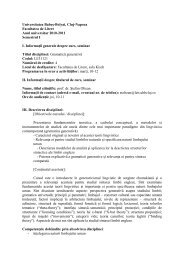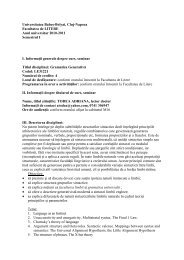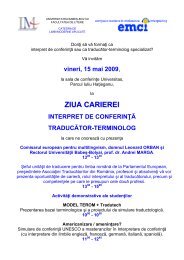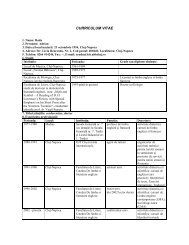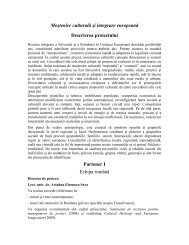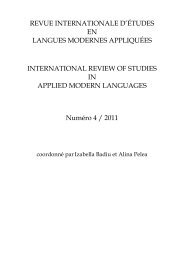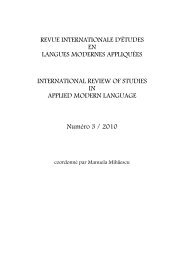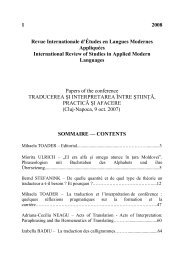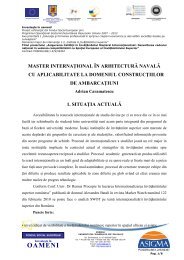Dimensiuni ale limbajului n context carceral
Dimensiuni ale limbajului n context carceral
Dimensiuni ale limbajului n context carceral
You also want an ePaper? Increase the reach of your titles
YUMPU automatically turns print PDFs into web optimized ePapers that Google loves.
one slogan, but in the long run, as the brand becomes an iconic brand, more slogans are created to define,<br />
represent and advertise that specific brand. It is clear that brands and slogans work together, completing<br />
one another. A brand is not a complete and real brand, if it has no slogan. In addition, it would be a lot<br />
harder for a brand to get noticed and adopted by customers, without it having at least one catchy slogan,<br />
because people consciously or unconsciously buy a product that has interesting, humorous, original,<br />
attractive and intelligently created slogans and adds, rather than a product that is only slightly advertised.<br />
The slogans of a brand define positive characteristics of that brand, highlighting not only its greatness,<br />
but also the necessity of making that product your own. Slogans are used in more fields, such as<br />
advertising, commerce, politics and religion. They are short, rhetorical and they do not present many<br />
details. The word motto is appropriate to define a slogan, because it is easy to memorize and it has a clear,<br />
logical meaning. A slogan is an expression created first for a specific society, with the key purpose of<br />
making the product liked, used, enjoyed by people, rather than being only a projection for an audience.<br />
Slogans function as:<br />
a) a description of the product, often using the superlative: e.g.:<br />
“Milka, cea mai fină ciocolată” (Milka)<br />
b) a description of the feelings it transmits:<br />
e.g.: “A,B,C,D,E,…Your public library has arranged these in ways that make you cry, giggle, laugh,<br />
love, hate, wonder, ponder and understand.” (American Library Association)<br />
c) an urge:<br />
d) a metaphor:<br />
e) a comparison:<br />
e.g.: “Always Coca- Cola” (Coca- Cola)<br />
e.g.: “The Joy of Cola.”, or: “Welcome to the Coke side of town.”(Coca- Cola)<br />
e.g.: “Reach out and touch someone.” (American Telephone Telegraph)<br />
e.g.: “Let’s make things better 1 ” (Philips)<br />
e.g.: “You’ll be lovelier each day with the fabulous pink Camay.” (Camay soap)<br />
Some slogans are formed:<br />
1) by exagerating:<br />
e.g.: “Impossible is nothing.” (Adidas) or:<br />
e.g.: “I’d walk a mile for a Camel” (Camel cigarettes)<br />
2) by playing down everything else:<br />
e.g.: “Nothing else” (Lucky Strike)<br />
e.g.: “Break your plans and stay with us to see Comedy Central.” (Comedy Central)<br />
3) by enumerating actions or things:<br />
e.g.: “A,B,C,D,E,…Your public library has arranged these in ways that make you cry, giggle, laugh,<br />
love, hate, wonder, ponder and understand.” (American Library Association)<br />
1<br />
The idea transmited through the comparative better is let’s make things better than they already are; so Philps compared to what<br />
already exists is a lot better.



